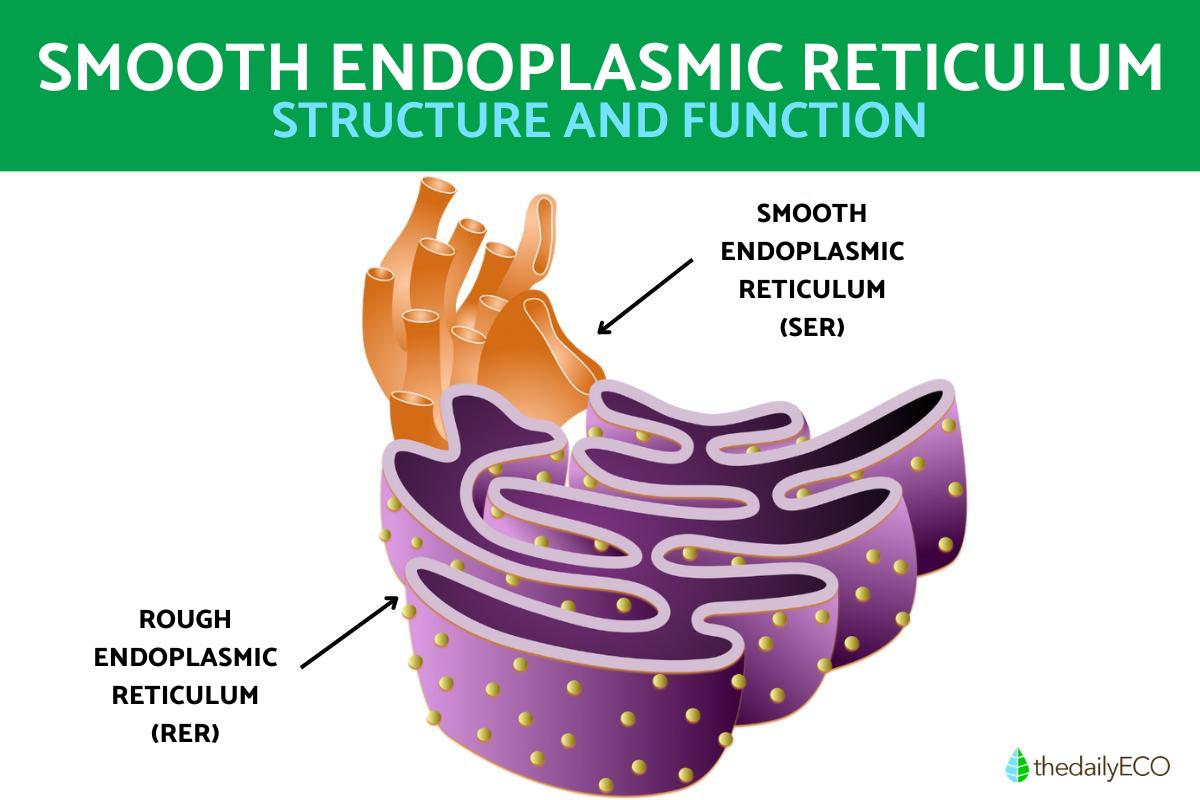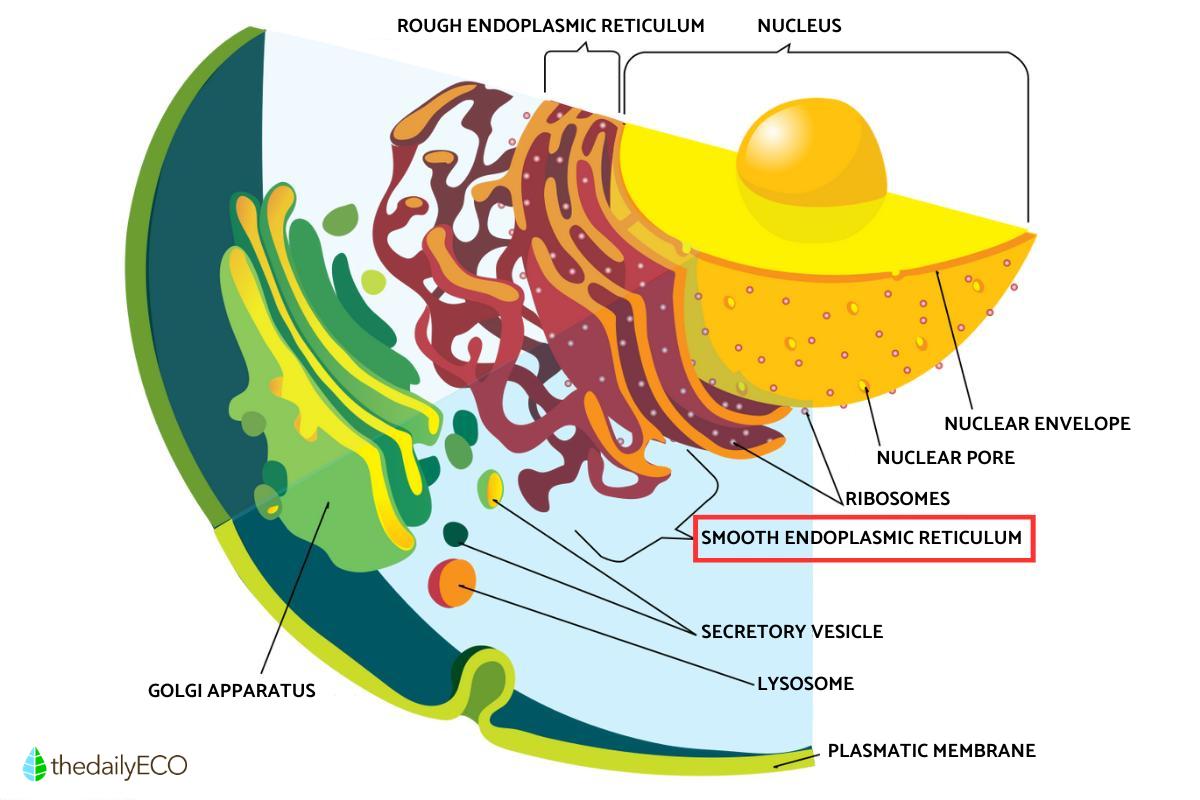What Is the Smooth Endoplasmic Reticulum and Its Function?


The endomembranous system is a set of membranes and structures in eukaryotic cells that collaborate in the modification, packaging and transport of lipids and proteins. The smooth endoplasmic reticulum (SER) is a network of tubular and membranous structures which are connected to each other. Their function is to facilitate various process within the cells such as lipid production, carbohydrate metabolism, detoxification of harmful substances and storage of calcium ions. These processes are necessary for the survival of the cell, in turn being necessary for the continuation of the greater organism.
In this thedailyECO article, we ask what is the smooth endoplasmic reticulum and its function? We discover its various roles within the cell and provide diagrams to help us better visualize them.
What is smooth endoplasmic reticulum?
The smooth endoplasmic reticulum (SER) is a type of cellular organelle found in eukaryotic cells. It is distinguished by its smooth appearance and the fact it does not have ribosomes attached to its membrane. It is this characteristic trait which qualifies it as smooth. It is an organelle that consists of interconnected tubular and membranous structures which continue through to the cisternae of the rough endoplasmic reticulum (RER).
Both the SER and the RER are part of the single organelle which is known as the endoplasmic reticulum. Since it is only found in types of eukaryotic cells, it is found in cells which contain a nucleus. However, not all eukaryotic cells have an endoplasmic reticulum with red blood cells and sperm cells being notable exceptions. As you can see, the nucleus is apparent in the diagram of a eukaryotic cell below.
Learn more about the difference between eukaryotic and prokaryotic cells in our related article.

Function of the smooth endoplasmic reticulum
As with other types of cell organelle, the smooth endoplasmic reticulum has different functions within the cell. These functions can depend on the type of cell, since it will depend on their location and the type of tissue in which they are present, among other factors. The functions of the SER include:
- Lipid synthesis, storage and transport: the smooth endoplasmic reticulum is responsible for the synthesis of a wide variety of lipids. These include cholesterol, phospholipids and glycolipids, all of which are essential components of cell membranes. It also stores and transports lipids to other parts of the cell.
- Muscle contraction: in muscle cells, the smooth endoplasmic reticulum, specifically the sarcoplasmic reticulum, plays an important role in muscle contraction. The sarcoplasmic reticulum stores calcium ions that are released during muscle excitation. In doing so, it triggers coordinated contraction of muscle fibers. When the SER is found in muscles cells, it is known as the sarcoplasmic reticulum (SR).
- Detoxification: the smooth endoplasmic reticulum contains detoxifying enzymes that help degrade fat-soluble and toxic substances. As it does so, it transforms them into soluble substances that can be excreted by the body. This function is especially important in the liver where the smooth endoplasmic reticulum helps in the detoxification of compounds such as drugs and toxins.
- Release of glucose from glycogen: in hepatocytes (liver cells), the smooth endoplasmic reticulum is involved in the release of glucose from stored glycogen. Glycogen is broken down into glucose-6-phosphate in the cytoplasm, providing a source of energy when needed. Learn more about what is the cytoplasm and its function in our related article.
- Production of transport vesicles: the smooth endoplasmic reticulum is also involved in the formation of transport vesicles containing newly synthesized proteins and lipids. These vesicles are subsequently transported to the Golgi apparatus, where they are processed and directed to their final destination inside or outside the cell.
Structure of the smooth endoplasmic reticulum
The smooth endoplasmic reticulum (SER) is distributed throughout the cytoplasm of the cell and is composed of a network of interconnected membranous tubules. Unlike the rough endoplasmic reticulum (RER), the SER does not have ribosomes attached to its membrane. The structure of the SER can vary in different cell types. Some do and others do not present cisternae, expansions or dilations in the reticulum's shape.
Within the rough endoplasmic reticulum, there are also small sections of smooth endoplasmic reticulum. These sections act as exit sites for vesicles that are shed from the rough endoplasmic reticulum and are known as the transitional endoplasmic reticulum.
You can see the ribosomes represented by red dots in the diagram below.

Difference between smooth and rough endoplasmic reticulum
The smooth endoplasmic reticulum (SER) and the rough endoplasmic reticulum (RER) are two distinct components of the endoplasmic reticulum (ER) with different functions in the cell. The following characteristics help us to distinguish between the two interrelated and interconnected organelles:
- Appearance: the SER is characterized by lacking ribosomes attached to its membrane, giving it a smooth appearance when viewed under a microscope. In comparison, the RER has ribosomes attached to its outer membrane, giving it a rough appearance.
- Function: the SER is involved in lipid synthesis, carbohydrate metabolism, calcium storage and detoxification of toxic substances. On the other hand, the RER is mainly responsible for protein synthesis and its subsequent modification.
- Location: the SER is distributed in the cytoplasm of the cell, while RER is located closer to the nuclear membrane.
- Structure: the SER has a more tubular structure, made up of a network of interconnected membranous tubules. In contrast, the RER has a more complex structure due to the presence of ribosomes attached to its outer membrane. These structures can be seen in the diagram below.
- Abundance: the SER is abundant in cells that require lipid synthesis and metabolism, such as liver cells responsible for detoxification. The RER is more abundant in cells specialized in protein synthesis, such as pancreatic cells that produce digestive enzymes.
Now that you know what is the smooth endoplasmic reticulum and its function, you may want to learn more about the structure and function of different types of cells. You can do so with our article on the phases of the cell cycle and the difference between haploid and diploid cells.

If you want to read similar articles to What Is the Smooth Endoplasmic Reticulum and Its Function?, we recommend you visit our Biology category.
- English, A. R., Zurek, N., & Voeltz, G.K. (2009). Peripheral ER structure and function. Current opinion in cell biology, 21, 506-602.
- Lodish, H., Berk, A., Zipursky, S. L., Matsudaira, P., Baltimore, D., & Darnell, J. (2016). Molecular Cell Biology (8th ed.). WH Freeman.








